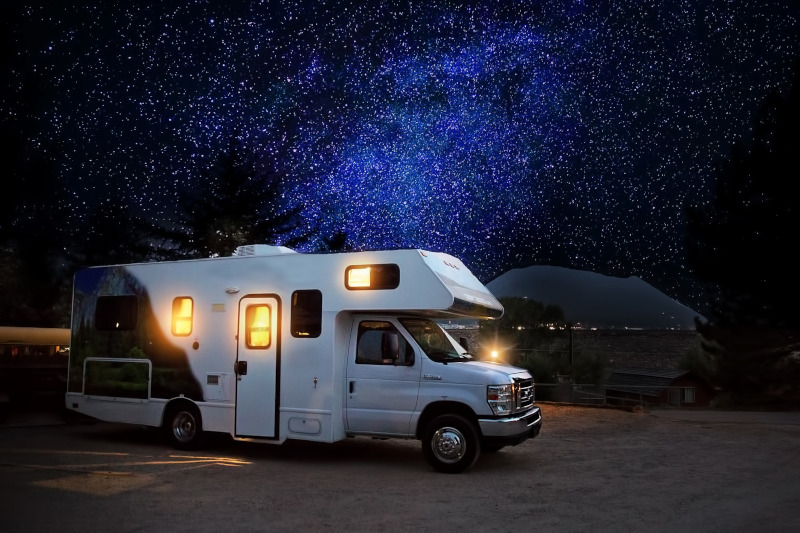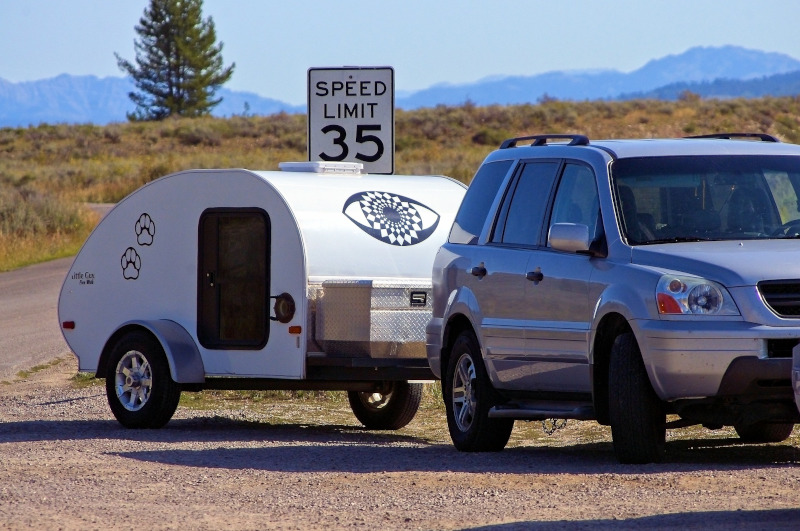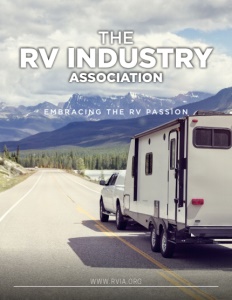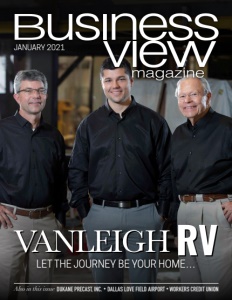The RV Industry Association
Embracing the RV passion
Business View Magazine interviews Craig Kirby, President of the RV Industry Association, for our focus on the North American RV Industry
With offices in Reston, Virginia and Elkhart, Indiana, the RV Industry Association is the leading trade voice of the $114 billion dollar RV industry, representing approximately 400 manufacturers and component and aftermarket suppliers who together produce 98 percent of all RVs made in the US, and approximately 60 percent of RVs produced worldwide. Big numbers for an association with an even bigger mandate – to promote and protect the industry and its members.
The association’s roots extend back to 1963, when the American Institute of Travel Trailer and Camper Manufacturers was incorporated in the State of Indiana as a not-for-profit corporation. In 1968, the organization officially rebranded as the Recreational Vehicle Institute, Inc. (RVI) and moved its offices to Grand Rapids, Michigan and, a few years later, to Des Plaines, Illinois. In 1974, the organization changed its name to the Recreation Vehicle Industry Association, Inc. (RVIA), combining elements of RVI and the Travel Coach Association (TCA) of Riverside, California. Two years ago, the organization went through a brand refresh resulting in a more concise name: the RV Industry Association. Today, the RV Industry Association is a robust organization that works with federal and state lawmakers and regulators to pursue a favorable business environment for its members, is the leading source of research, data, and analysis about the RV industry, and seeks to grow and expand the RV consumer market while cultivating a positive experience for current and future RVers.

During the COVID-19 pandemic, as people eagerly seek out ways to leave the house for a change of scenery while maintaining a safe social distance, all thing recreational have soared. That holds especially true for the RV industry, where sales have been booming. Craig Kirby, RV Industry Association President, reports, “At the beginning of COVID, the industry was shut down for two months and no one knew what to expect when things improved and places began to open back up. But, surprisingly, we are on track to end 2020 with about 424,000 units – which is what we estimated at the beginning of the year. So for having been shut down for two months at the manufacturing and the dealer end, to finish at that level is quite amazing. During the shutdowns, a number of manufacturers also started producing PPE, and units were donated to hospitals and others for various uses. So impressive.”
It all comes down to people loving the fact that an RV offers the freedom to go where you want, when you want, while also controlling your environment. When you travel, you can use your own bathroom, cook your own meals, bring your own bed… “And they’re just a lot of fun!” says Kirby. “Getting out in nature, hiking, fishing, it’s a great way to pursue your passions. We are thrilled that people are able to use our product to escape the stress of the pandemic and experience the outdoors.”
From a manufacturing perspective, there have been some supply chain shortages because the demand for RVs came back so fast and so strong. And the lack of skilled tradespeople continues to cause challenges for industries across the board, including the RV sector. But the manufacturers are still producing a high volume and expanding. Interestingly, 55 to 70 percent of the purchases are from first-time buyers; the majority under age 45. That was the fastest growing segment prior to the pandemic and it has continued to increase. Kirby reflects, “That bodes well for excellent growth for the industry because once people get an opportunity to try RVing, we believe they’ll be hooked on the lifestyle and will remain in the industry. From that perspective, we’re excited to have so many first-time buyers.” A recent survey from the association also showed that Millennials have the strongest RV purchase intent, followed closely by Gen X and Gen Z.
The association now has fewer members than in recent years, as a result of consolidation at the supplier and the manufacturer level. Currently, three manufacturers make up approximately 90 percent of the total RV production. To best serve its members, the association puts a strong focus on its signature programs. Go RVing, the association’s advertising campaign attracts new consumers to RVing and conducts consumer research and insights. The Standards program maintains and contributes to the creation of industry safety standards. As part of that initiative, inspectors go out once every eight weeks, unannounced, and audit compliance to these standards while also providing education on how to comply with the latest standards. And they will cite manufacturers that are not in compliance.
The RV Industry Association also advocates at the state and federal level on issues that will impact the industry through the association’s Government Affairs program. They played a significant role, along with industry partners in the Outdoor Recreation Roundtable, in getting the Great American Outdoors Act (GAOA) passed last summer. GAOA secured $9.5 billion in funding for national parks and other federal lands, some of which will be used to modernize and enhance campgrounds, in addition to many other infrastructure improvements. That Act is the most important piece of legislature in six decades for outdoor recreation and our federal lands.

With regard to the pandemic, the Government Affairs team worked to have the industry declared an essential business, with the understanding that everyone was operating in compliance with CDC requirements. What made this effort successful was an industry relaunch taskforce established by RV Industry Association Chairman Garry Enyart. The taskforce brought together people from companies across the entire RV industry, including the RV Dealers Association and the National Association of RV Parks and Campgrounds. “This industry unity not only allowed us to ensure RV companies were considered essential, but it also allowed us to respond faster to the pandemic than other industries,” Kirby adds.
The biggest new initiative for the association is the RV Technical Institute (RVTI) that was established specifically for training and recruiting RV service technicians to address an industry-wide shortage for skilled RV service technicians. Kirby explains, “The RV Industry Association and Go RVing provided seed money for RVTI to purchase a building in Elkhart and set up shop. We have a board made up of manufacturers, suppliers, and dealers that works with the RVTI staff on developing great training curriculum for technicians. One of the things we’re working on as an industry is to reduce what we call the repair event cycle time – the time from when a consumer takes their RV into a dealer and it gets repaired and returned to them. Our Institute will help in that regard, by addressing the need for skilled technicians.”
In addition to the in-person training available at the RVTI headquarters and through their training partners, RVTI launched a new Level One online training program that allows students to complete the course at their own pace, according to their own schedule. Kirby adds, “We expect the online program to be extremely successful and hope we’ll be able to train more technicians than ever. Level One is just the first stage, we’ve already started development of the Level Two program that is expected to be ready by mid-2021. The curriculum has been created over the past few years with input from subject matter experts from across the industry. We couldn’t have moved so quickly to launch the online program without that solid framework. Launching the online program was in the plan, the pandemic just accelerated the timeframe.”
Another critical part of the RVTI program are the authorized learning partners across the country – a network of regional partners approved to deliver RVTI’s standardized training on a local or regional basis. These partners include RV dealership, state RV associations, RV manufacturer companies, and state agencies. With the multiple delivery methods and training over 300 RV techs in 2020 despite the pandemic, RVTI is on track to be self-supporting a year ahead of time. That’s a huge achievement for the industry.
The RV Industry Association has always been great at communicating with members, but when the pandemic hit, they turned it up several notches. “Our team, in the last several months, reached out to every single member twice,” says Kirby, “just to see how they’re doing, make sure they understand all the resources we have available –to let them know, ‘Hey, we’re your Washington, D.C. office, we’re part of your team.’ And that communication was very helpful. The weekly newsletter became a twice-weekly newsletter. We also increased our webinars and trainings, including a workplace safety seminar during the spring lockdowns. The point of that seminar was to get our manufacturers and suppliers together to develop a back-to-work playbook to ensure a safe environment when the employees came back to the job. We did not want safety to be a competitive issue so, to the credit of our members, the group got together online and talked about the measures they were instituting to comply and go beyond CDC guidelines. I’m proud of how our industry stepped up to do its part during COVID.”
Looking ahead, industry forecasts show that interest in the RV experience will continue to grow. RV shipments in 2021 are forecasted to top 500,000 units for only the second time in history. Consumer research has found that more than 61 million people plan on taking an RV vacation in the next 12 months. Kirby admits, “That’s a really high number. The other thing people don’t realize is that you can get into the RV industry for as little as $6,000 for a folding camping trailer, and it goes up from there. Many of this year’s most popular travel trailers have been in the very affordable $25,000 range. There really is a product for every consumer price point and that diversity is a major reason for the industry’s tremendous growth.”
Currently, the inventory levels on dealer lots is low. According to Kirby, “It’s going to take quite some time to get them back up to their pre-pandemic level. With all the new buyers embracing the RV experience, that bodes well for the industry for many years to come. The RV Industry Association will continue to be the voice of the members, to promote and protect the members. One of the things we’ve strived to do is to listen to members and place them first. As long as we’re doing that, we’ll be providing the value that’s important to our members and that’s really the RV Industry Association focus.”
AT A GLANCE
The RV Industry Association
What: A national trade association representing RV manufacturers and suppliers
Where: Reston, Virginia
Website: www.rvia.org


